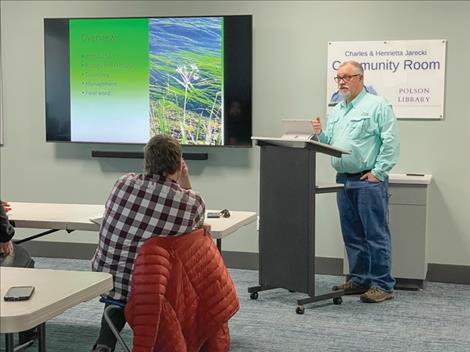Stakeholders meet to discuss aquatic invasive weed management
Hey savvy news reader! Thanks for choosing local.
You are now reading
1 of 3 free articles.
POLSON — Area stakeholders met on March 7 for an informational meeting and subsequent discussion about aquatic invasive weeds on the Flathead Reservation and what to do about them.
Visiting consulting scientist Dr. John Madsen gave extensive presentations during the meeting on the science of Flowering Rush and Eurasian Watermilfoil plants – two aquatic invasive weeds found on the reservation.
Representatives from the Confederated Salish and Kootenai Tribe Hydrology Department and Aquatic Invasive Species Program, the Flathead Irrigation Project, US Fish and Wildlife Service, Montana Fish, Wildlife and Parks and the Salish Kootenai College Extension Office met at the North Lake County Public Library to learn more about the invasive weeds and how to manage/eradicate them.
CSKT Aquatic Invasive Species Program Manager Katie Finley-Squeque, who organized the event, said that Flowering Rush, found both in Flathead Lake and Flathead River, has been in the area for a while. Eurasian Watermilfoil however, was newly discovered in Pablo Reservoir in 2022 following an FWP request for a survey of all reservation waters. Since Eurasian and Northern Watermilfoil (a plant native to the area) look similar, the plant was sent in for testing and discovered to be the invasive Eurasian variety.
Invasive weeds can cause a variety of problems – from destruction of native plants and wildlife habitat to blockage of irrigation waterways and damage to boats. Thick grows of invasive weeds have also been linked to human drowning deaths, Finley-Squeque pointed out. Invasive fish (such as Northern Pike) also like to hide in dense areas of Flowering Rush to prey upon native fish species.
The land Pablo Reservoir is situated on is owned by the CSKT, while the water is managed by the Flathead Irrigation Project (BIA). The land however, is managed by the US, Fish and Wildlife Service and all parties must be in agreement about how to address the issue. The response, Finley-Squeque explained, will be a collaborative effort.
“I’m just leading the charge,” she said with a smile. “It’s great having so many awesome partners that want to work together and help each other out.”
The March 7 meeting, held at the North Lake County Public Library meeting room in Polson, was an opportunity for all involved to meet and discuss weed management options.
At this point, provided she’s able to secure funding, Finley-Squeque said the plan is to hit the ground with an herbicide following the fall drawdown of irrigation waters (either this year or next.)
She added that current measures (both physical and chemical removal) to keep weeds from obstructing FIIP irrigation canals may already be helping to keep the Eurasian Watermilfoil from spreading further.
Further meetings will be held in the future to coordinate herbicide application and timeframes.
















